2016 Triumph Street Twin First Ride Review
Triumph gambles that less will be more with its new Street Twin
Wow, this is sort of dangerous ground Triumph is treading with its new Hi-Torque-engined Street Twin: Its all-new bigger, more modern, liquid-cooled 900cc parallel-Twin actually makes, ahhhh, less peak horsepower than the previous generation 865cc unit. That’s why they insisted we journalists ride the bike before the tech presentation, and kept the cocktails flowing the night before. Savvy marketing on their part. Triumph claims just 54 horsepower (at 5900 rpm) for the new motor, which is at least 10 hp less than I’d have estimated from my butt-clench dyno after a day’s spin around Valencia and environs on the new bike.
2016 Triumph Street Twin
| Engine | 16.5/20 |
| Suspension/Handling | 13.0/15 |
| Transmission/Clutch | 8.5/10 |
| Brakes | 8.5/10 |
| Instruments/Controls | 4.5/5 |
| Ergonomics/Comfort | 9.0/10 |
| Appearance/Quality | 9.0/10 |
| Desirability | 7.5/10 |
| Value | 8.0/10 |
| Overall Score | 84.5/100 |
2016 Triumph Street Twin Announced
That’s because it’s way torquey; the Street Twin gets the new Hi-Torque motor, with a single 39mm throttle body keeping intake velocity high at low rpm (other Bonneville versions will get a Hi-Power 1200cc version of the new Twin with two throttle bodies, to be launched by Triumph over the next few months). I’m a vocal fanatic of Honda’s NC700X, and 10 years ago you couldn’t shut me up about the Buell XB-9S. The new Street Twin is a lot like both of them, in fact it’s somewhere in the middle since it makes more power than the Honda but less than the Buell. Also, like the Honda, its other claim to fame is 36% greater fuel efficiency than the old Bonneville: Triumph says it’ll get 60.8 mpg in urban use, and one of the engineers who’d been riding one a lot said he routinely gets around 64 mpg. At the end of my 150-mile day, my bike said it was getting 63.8 mpg. Which is a good thing, since the Street Twin gets a smaller tank than the other new Bonnies, only 3.2 gallons. The new engine also exceeds Euro 4 regulations.
Basically then, if you were expecting a blazing fast new beginner Bonneville, you’re disappointed. For most Bonneville buyers, according to Triumph, it won’t be a big deal at all. Buyers of bikes like this one (and the Ducati Scrambler, etc.), they say, don’t look at spec charts (and for the those who do, the new T120 and Thruxtons will be here shortly with the Hi-Power version of the new Twin).
Frankly, it wasn’t a problem for me either. Even in “sporting” use, most people just don’t rev their motorcycle to redline very often, and the new bike really does have a very meaty midrange just like the chart shows; the Street Twin is a torquey little beast that gets it done. It’s not a wheelie monster like the old Buell was, but it’s faster than the NC. Strangely enough, for a bike with a 7000-rpm redline, I never banged into the rev limiter except when I did it on purpose; it’s a soft one, and feels farther up the dial than 7000 rpm. (You can’t really know since there’s no tachometer, not even a digital one you can scroll to.) The Triumph’s torquey enough down low and geared tall enough to satisfy your baser instincts without really wringing its neck. In top gear (fifth) and pulling hard past 90 mph, it felt just as easily willing to punch right past 100 mph as the Indian Scout Sixty I tested two weeks ago did – but on the Triumph I kept running out of straight or empty lane before I could quite get there. Spain’s not Las Vegas.
Part of that is down to the Street Twin’s reduction in mass. The old Bonneville was nothing like light; the new one’s really only lost about 12 pounds (478 wet, says Triumph) when you factor in that it carries one gallon (six pounds) less fuel, but it feels like it’s lost more. It weighs something like 80 pounds less than an Indian Scout Sixty, which isn’t the Triumph’s real competition. But it’s also around 60 pounds heavier than a Ducati Scrambler, which is.
Compared to the previous Bonnie, though, wheelbase is two inches shorter, rake is two degrees steeper and trail – at 102mm – is 4mm shorter. Those numbers and the reduction in weight conspire to make the new Twin a happy, willing partner in the curvy Spanish countryside through the orange and olive groves. The front tire is a 100/90-18 bias ply, the rear a 150/70 R17 radial Pirelli, a combination engineer/test rider David Lopez says Triumph played with for over a year to get right. Lifting the tread pattern from the classic Pirelli Phantom race tire of yore lends a nice period touch as well.
Those tires ride a 41mm fork in front with 120mm travel, and a pair of shocks out back with dual-rate springs (also 120mm travel). The ride feels really bump-absorbent, plush and well-damped around town – a great urban scoot and commuter – and I didn’t experience a single kidney shot from bottoming out all day. It’s also firm enough to flog pretty hard in the mountains under my 165 pounds of rider and gear. It’s just soft enough to encourage you to attempt to not make any really sudden moves, but you can ride it like a modern motorcycle with no complaints when you need to; mash both brakes all the way into bumpy apexes. No skittering, no problem.
Again, like on many “entry-level” bikes lately, the front brake caliper is a slide-type two-piston bargain-bin unit (Nissin), but it has no problem yanking the bike down from speed with excellent feel and modulation, especially if you use the rear at the same time, which is easy to do thanks to standard ABS. Lopez, the engineer, says the Street Twin’s new geometry and weight distribution give it some of Triumph’s best 60-to-0 stopping distances, thanks to excellent balance. Along with new rake and trail numbers, the new bike carries more of its weight on its front tire, which gives it a generally more modern feel than the previous one.
In curvy road mountain terrain, the new bike’s more connected to the road even if it’s not as powerful up top. The torque down low seems to make up for it, squirting the bike out of corners. (It doesn’t usually feel like it needs the switch-offable traction control, but it’s nice to have when it’s damp.) The ride-by-wire mechanism is contained in the throttle housing, and power feeds in smoothly when rolling it open from any rpm. On the kind of twisting roads where motorcycles belong, it feels like the Street Twin could keep up with lots of sportier, more powerful bikes through really good systems integration; all components play together nicely, while transparent ergonomics and handlebar instill confidence.
With less than 500 miles showing on my test bike’s odometer in the morning, I could feel the five-speed gearbox breaking in as I rode it, or maybe the oil just getting warm? Clutch pull is really light and a little grabby when cold, but the gearbox works fine when it’s warm, allowing easy clutch-free up and downshifts when you’re feeling aggressive, and even a little dirtbike style clutch-fanning now and then.
On the other hand, it’s the kind of bike you can just roll leisurely along upon and enjoy the scenery. For 5-foot-8 me, the riding position is ideal, the seat’s perfectly comfy, and the 270-crank engine feeds practically zero vibration into the chassis at any rpm, even though it’s bolted in solidly, thanks to not one but two counterbalancers. It’s more compact than the old bike, and it’s nice on chilly days to be able to caress the cylinder head with your knees for a little warmth. (Heated grips are one of many options.)
The bike comes with a handy USB port under the seat and a 12-volt outlet on the headstock, and with this bike Triumph is on the accessorizing bandwagon with over 150 hop-up and customizing accessories including different seats and luggage, exhausts, flyscreens – the Scrambler kit above is available in Europe and probably will be here in the U.S. as well, complete with Vance & Hines pipe with removable baffle, tiny taillight, brown ribbed seat, etc… And now Triumph will begin making a greater effort to sell clothing and accessories too, why not? Other companies make a killing on their t-shirts.
There you have it. The OG British Superbike, circa 1965, takes on an entirely new character in the new Street Twin, a modern classic set to inspire a new generation, Triumph says, of riders who appreciate the overall experience more than they desire to reset the land-speed record. Should be fun to see how it plays out, and even more fun to sample the new T120 Bonneville and Thruxton as they roll out over the next couple of months. And for us old codgers, maybe the most fun of all will arrive with the new Speed Triple around June, a bike the Triumph people had to bite their tongues hard to keep from talking about. Something for everybody.
2016 Triumph Street Twin Specifications | |
|---|---|
| Engine Type | Liquid cooled, 8 valve, SOHC, 270° crank angle parallel Twin |
| Displacement | 900cc |
| Bore/Stroke | 84.6 x 80 mm |
| Compression Ratio | 10.55:1 |
| Maximum Power (claimed) | 54 HP (40.5kW) @ 5900 rpm |
| Maximum Torque | 59.0 lb-ft (80Nm) @ 3230 rpm |
| Fuel system | Multipoint sequential electronic fuel injection |
| Exhaust | Brushed 2 into 2 exhaust system with twin brushed silencers |
| Final drive | O ring chain |
| Clutch | Wet, multi-plate assist clutch |
| Gearbox | 5-speed |
| Frame | Tubular steel cradle |
| Swingarm | Twin-sided, tubular steel |
| Front Wheel | Cast aluminum alloy multi-spoke 18 x 2.75in |
| Rear Wheel | Cast aluminum alloy multi-spoke 17 x 4.25in |
| Front Tire | 100/90-18 |
| Rear Tire | 150/70 R17 |
| Front Suspension | Kayaba 41mm forks, 120mm travel |
| Rear Suspension | Kayaba twin shocks with adjustable preload, 120mm rear wheel travel |
| Front Brake | Single 310mm disc, Nissin 2-piston floating caliper, ABS |
| Rear Brake | Single 255mm disc, Nissin 2-piston floating caliper, ABS |
| Instrument Display/Functions | LCD multi-functional instrument pack with analogue speedometer, gear position indicator, fuel gauge, range to empty indication, service indicator, clock, trip computer, scroll button on handlebars, TPMS ready, heated grips ready, fuel consumption display and traction control status display. |
| Length | 2090 mm |
| Width (Handlebars) | 785 mm |
| Height Without Mirrors | 1114 mm |
| Seat Height | 750 mm |
| Wheelbase | 1439 mm |
| Rake | 25.1º |
| Trail | 102.4 mm |
| Dry Weight | 436.5 lbs |
| Fuel Tank Capacity | 3.2 gallons |
| Fuel consumption | 72.8 mpg at constant speed of 56 mph 52.0 mpg at constant speed of 75 mph Combined 63.3 mpg* * Figures obtained according to the emissions procedure GTR2 of the World Motorcycle Test Cycle (WMTC). |
| Emissions | Euro4 Standard: CO2 – 87.0 g/km |
| Other Standard equipment | ABS, Traction Control, Ride-by-wire, Immobiliser, USB socket, LED rear light |
More by John Burns



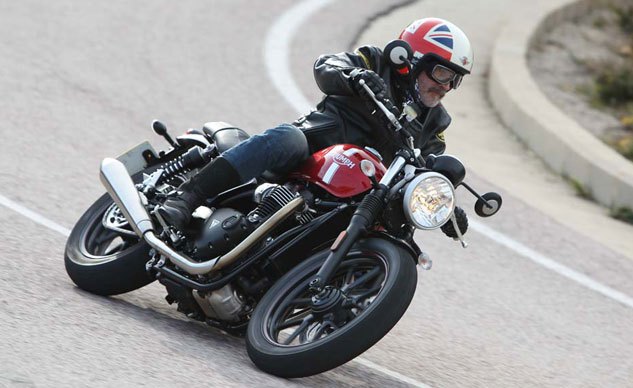

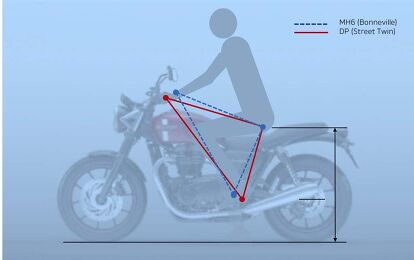

































































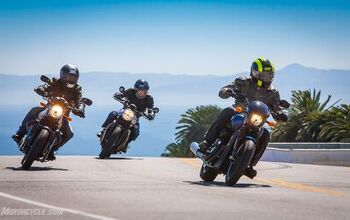
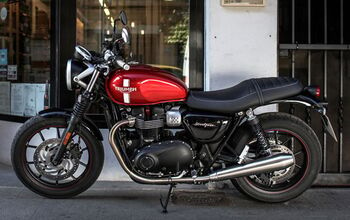
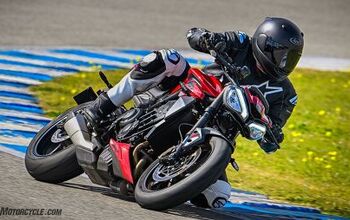













Comments
Join the conversation
Nice review. Thanks for that.
Sounds (and it does) like an under powered Ducati.